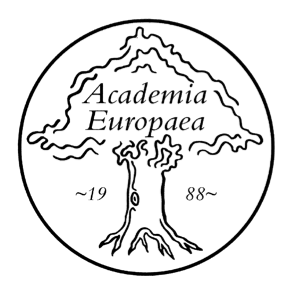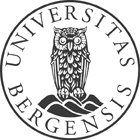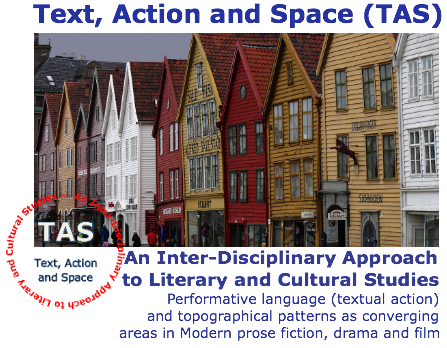Mission


TAS' Mission
[Link to pdf]
TAS stands for “Text, Action and Space (TAS). Performative language and topographical patterns as converging areas in modern drama, prose fiction and film. An inter-disciplinary approach to literary and cultural studies”. (In Norwegian this reads as: “Tekst, Handling og Rom”, cf. the TAS-researcher group’s link on the webpage of the Dept. of Linguistic, Literary and Aesthetic Studies (LLE/UiB). – The TAS project’s previous and individually constructed homepages are to be found, with sub-links, here.)
Basic platform: TAS takes its point of departure within a broad, comparative material selected from Modernity’s literature, drama, film and other arts, and in speech-act theories. The latter are theories about language and about textuality in a wider sense, and while not primarily focusing on the individual art works’ story lines, plots or the like (that too), yet they investigate the art works’ textual action (on levels above concrete and readily recognizable contents, plots, character actions, etc.) Speech-act theories constitute thought about literature and art’s performative characteristics. While they are not merely concerned with what literature, film, drama and visual culture communicate, “mirror”, and let come representatively to the fore as something known and recognizable, yet, and in particular, they bring to attention what literature and the arts in alternative acts of representation make happen (as events in language). In other words, performativity theories are concerned with what literature and the arts – with their textual and medial action – effectuate and bring into the world, what they install, make alterations to, transform, and creatively engender and introduce as novelties that prior to the utterance had no existence. A basic theoretical reference is found in J.L. Austin’s speech-act thought along the critical trajectories it received and underwent in Derrida, Hillis Miller and a series of other scholars’ versions, including a host of other, more recent theoretical landscapes that are compatible. – The works of art analyzed by TAS, have been selected from Scandinavian, Central-European and Anglo-American canons, yet they are also and not least selected from more recent literature and art forms. Occasionally, TAS in addition selects for scrutiny works of art from outside of these bounds, as exemplified for instance by Ancient Drama and Asian literature.
Composition of TAS’ researcher group: TAS is an inter-aesthetic, international and comparative project. We organize our work both in the form of Workshops and as networking together, in ways that are compatible with all of us at the same time serving full duties on our individual, domestic academic grounds. Our focus is on literature and art works of quality, and on the inclusion, within each phase and part-project, of competent researcher-group members – precisely on that authorship, that period, that cultural field. Furthermore, TAS composes its researcher group (in the range of 20-odd participants) out of scholars that together traverse the researcher generations: In this manner, TAS comprises senior scholars, juniors, postdoc’s, PhD students, and occasionally we also include Masters or Master-degree students. – In so doing, we surmise that TAS represents and operates as a viable model for research in the humanities – based on quality, with the exchange of insights and not least the mutual generating of knowledge across disciplines, nations and generations, and above all with a space for the participation of more recent and younger scholars – and all of the above within relatively limited budgets. – Originally, the TAS Project commenced in ideas discussed between the project leader and his late senior colleague, prof. Atle Kittang († 2013), who immediately engaged in productive exchanges, rendered support, gave inspiration and came up with additional suggestions. While the two of them initially built and developed the project in collaboraton, yet Kittang all the way insisted that Sætre alone should be TAS’ project leader. On Kittang’s part, he served as a standing member in TAS’ Leader Group as well as in the extended, TAS-internal, peer-reviewing Editorial Group. Atle Kittang rendered a major contribution in all phases during our years of working together, all the way up to his passing away.
TAS’ fashion of working: At the cusp of each new project phase the researcher group is consolidated and renewed relative to the focus and the frames of the work about to be set in motion. Then the group convenes at Workshops (so far, held in Paris (French-Norwegian Centre at the FMSH) and in Bergen), at which we present part-project papers for each other – for discussion, commentaries and revising proposals, all of which takes place in an environment built upon mutual trust. Typically, a couple of Workshops are held during each phase – with the goal of eventual international publication in mind. Subsequent to our Workshops, the participants first revise their papers, reworking them into full-scale articles, upon which they are resubmitted to the TAS editors, who then cooperate with TAS’ extended Editorial Group. This segment consists of strict TAS-internal peer-reviewing, and responses are sent back to the individual authors comprising prospective wishes for further revising. Then a new deadline ensues for the re-submission of fully completed individual article manuscripts. Thereupon, the editors select articles and concatenate the current anthology into themes and relevant sections research-wise, as well as into a compositional totality. Only at this stage do we submit the book manuscript to our publisher, Aarhus University Press, upon which the AUP first embarks on its own, anonymous peer reviewing-process. The publisher then returns to us, occasionally with suggestions for minor changes. These are discussed with the individual authors, and finally, the whole master-document for an international book in academic English within the current TAS-phase topic is ready. In the wake of this, further cooperative work follows, now between the TAS editors and the publisher within the usual parameters up to publication. – With TAS, working and publication language is English at all stages. In cases where the primary literary and arts materials are in non-English languages, the main-text part of each article employs English translations, whereas at the same time quotes from the primary materials are rendered in their original language in footnotes.
Core areas: For critical investigation and analysis TAS has initially selected two textually central and dynamic areas that are particularly operative/textually actional, and which not least are shared (and in part converging) in the textual-medial languages of literature, drama, film and other media: (A) The study of literature and the arts’ performative language. This poetic/aesthetic language in literature and the arts is doubly actional: (a) in one sense of representation, by depiction and showing, it includes that which is already known and recognizable; (b) simultaneously, and in another sense of representation, it creatively alters the represented by way of installing; it transforms and re-creates text, media and discourse, and, in so doing, cultural spheres of value. (B) The study of the art works’ topographical patterns, i.e. spaces and spatial configurations in a variety of senses. This area comprises anything from formal spaces in texts and media (narrative codes, representational registers, image structures, etc.) to concretely geographic-topographical spaces, as well as other spaces in texts and media. Examples are mental spaces, existential spaces, spaces of value and jugdment, etc., even spaces without a phenomenologically or existentially known grounding: A number of Modernity’s literary, dramatic, filmatic and medial works open up towards and invoke a spatial/topographical outside in relation to the human life world. Also topographies perform actional work in our primary materials. – Both of these: the art works’ (A) performative action and (B) spaces or topographies (above the levels of plots and character actions) – and the blend of mimetic depiction (mimesis) and the actively transformational changes and novelties (creatio) of these two textual/medial areas – are, both of them, objects of close analytic scrutiny on each art work’s premises, including relevant observation of each art work’s genre and medial affiliation.
(1) Basic research: TAS’ first book, Exploring Textual Action (2010), figures as our basic-studies book. In this volume we have circumscribed how the performative and the topographical in the selected texts from literature, drama, film and the arts are structured and function aesthetically/poetically in the textual-medial interior. We also emphasize how performative textual action and topographical installation, transformation and novelty forcefully act in communities and cultures, and how they provide altered ways of being in and relating to culture. In TAS’ studies, cultural changes figure in the constitution of 4 fields: those of subjects/subjectivities, communities and cultures, the field of knowledge, as well as in the dominant discursive (linguistic, textual) regimes operative in culture. At the same time the volume offers analyses of a series of Norwegian, Scandinavian, European and Anglo-American works of art/authorships.
(2) The ensuing, thematically oriented research, related to our basic-research insights – first theme under scrutiny: texts, emotions and affects. In TAS’ second volume, Exploring Text and Emotions (2014), we have entered into the thematic analyses that the basic-research has facilitated. The book analyzes broadly selected literary, dramaturgical, cinematic and visual-art materials (Norwegian, Scandinavian, European, American, in this book also Ancient Greek Tragedy and Korean novelistic art). The anthology’s main focus is on how literature, drama, film and the visual arts (1) on the one hand mimetically depict and represent culturally and existentially operative emotions and affects, yet (2) on the other hand and in particular, install, creatively transform and supply a novel basis for feelings (emotions and affects) as a performatively ongoing artistic action. These dynamics occur in parallel with the language of textual action (the language of speech-acts; performative language), which qua literature and art basically feeds the manifaceted, concatenated art works analyzed in the volume.
(3) TAS Phase III (current): Remembrance and memory related to textuality and media: Focus and framework in this third TAS phase bring in analyses of another thematically operative field, also facilitated by the initial basic research: The current part-theme of this phase is textual and medial action related to the topographical/spatial field of recollection, remembrance and memory – seen in relation to each analyzed literary and art work’s actualization of the textuality and the mediality employed, inscribed, alluded to, or made use of in transformational ways.
(4….etc.) Further perspectives: In prospective, consecutive phases, and facilitated by our research so far, TAS plans to contribute with analyses of further, centrally operative thematic fields of cultural value – fields in which human and cultural reworking of existential and formal, thematic and topographical areas take place in literature and the arts by inclusion and recreation, yet where these are also altered by way of literature’s and the arts’ powerful installation, transformation and poetic/aesthetic creativity. To mention a few of the options, for example: love, the figuration of death, exstacy, madness, disease and illness, inter-personal relationships, the field of politics, the entanglement of human life into technology, etc.
Researchers; financing: Alongside the TAS group’s researchers from Bergen, Norway and Scandinavia, TAS in each research phase as well invites and includes Central-European researchers and scholars from overseas who are special experts within the selected research themes pertaining to each project phase. In its activities TAS both itself develops, as well as actively through networking joins a number of PhD researcher-training courses. Regularly, in TAS’ research Workshops at least half a day is especially designed to meet special tutoring requirements on the part of PhD students. These sessions discuss and respond with commentaries to the PhD candidates’ projects and their pre-submitted papers for the occasion. The furthering of the growth of new researchers is a basic concern to TAS; so is TAS’ engagement in channeling younger scholars into the international landscape of research and publication. Amongst the editors of each published volume TAS consequently also includes a PhD student. – During TAS’ first years, applications for funding were submitted to the Norwegian Research Council (NFR), each time for a 3-year, full-scale project. Repeatedly TAS achieved top-rated marks in the application processes. Typically in these rounds, while 70-80 projects competed on a national basis within the relevant NFR-programme sections, yet merely a maximum of 4-5 projects were given funding each time, and TAS in spite of its top ratings ended just below the funding line. However, TAS’ top NFR marks released regional funding allotted by the UiB centrally, from UiB’s Faculty of Humanities, and from the latter and the NFR within their mutual regional programme – means with which TAS economized and by the end of each fiscal year could save, and transfer for use later on. Thus financially enabled, TAS has so far funded 5 Workshops, expenses for the overall running of the project, as well as the expenditures for the publication of two comprehensive research anthologies. – The funding regime has changed somewhat over the years, and nowadays we are faced with the necessity to apply for means through the project leader’s LLE-department at the UiB, the Meltzer Fund and the University Fund (both at the UiB), the universities and departments of other TAS-participants, external research centres abroad (such as the French-Norwegian Centre at the FMSH in Paris), as well as other extra-mural organizations. Limited sums are being achieved bit by bit. – The Endorsement that TAS recently got bestowed by Academia Europaea for project quality and running viability is, meanwhile, of particularly high value in the current context. We also hope to be able to apply to the AE for means at a convenient occasion in the future.
